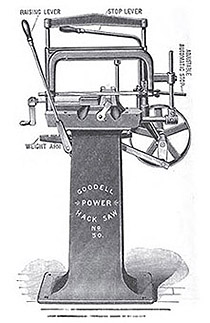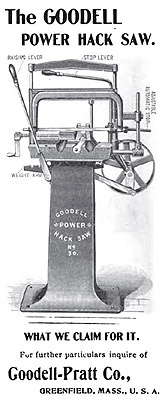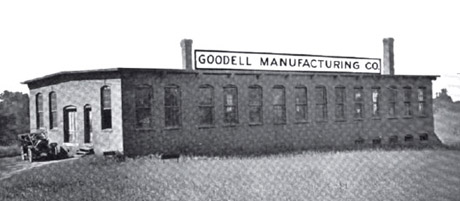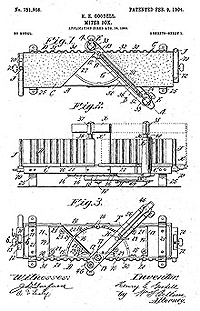|
|
|
|
|
|
|
Goodell-Pratt Company - Greenfield, MA
|
|
|
|
|
|
|
|
|
Goodell Brothers - the
Bedrock of Goodell-Pratt Co.
by Wiktor Kuc |
 11 of 19
11 of 19
 |
|
|
In a few months, the Bench Hacksaw
was modified and the belt-driven Power Hacksaw arrived on the market. In March, 1899 the
Machinery magazine published
its review:
"The Goodell Brothers Co., of Greenfield,
Mass., have just brought out and are putting on the market
their new power hacksaw, No. 30, an illustration of which is
shown herewith.
 The manufacturers state that they have
spent a long time experimenting upon machines of this
character, in order that this one might embody every
mechanical idea that experience and study could devise,
which would enhance its working value. It will be noted that the machine is very
compact and economizes floor space, and also that it’s
various working parts, and the operating levers, are
convenient to the hand of the operator when he stands in
front of the machine. The manufacturers state that they have
spent a long time experimenting upon machines of this
character, in order that this one might embody every
mechanical idea that experience and study could devise,
which would enhance its working value. It will be noted that the machine is very
compact and economizes floor space, and also that it’s
various working parts, and the operating levers, are
convenient to the hand of the operator when he stands in
front of the machine.
One of the features is an automatic
stop, which can be set to stop the saw at any desired depth
in the work, or after the same has been completely cut off.
This mechanism is instantaneous in its action. The starting or stopping lever is
connected directly with a clutch on the main driving pulley,
which either locks or disengages the crank shaft of the
machine. The vise is square with the saw, the bed of it
extending beyond the jaws to avoid the possibility of
 sawing
into the end of the work after it has been cut off. sawing
into the end of the work after it has been cut off.
The frame which carries the saw runs
in
a guide at its back, which, in turn, slides up and down on a
perpendicular guide rod, and the traveling motion is
conveyed with a horizontal guide rod, which runs parallel to
the blade of the saw.
Each machine is fitted and furnished
with one 12-inch Goodell Hack Saw Blade, and is capable of
sawing work 4 in. by 4 in. The dimensions of the
machine are as follows: Extreme height, 43 in.; height to
the top of vise, 28 in.; net weight, 150 pounds."
In April, 1899 Goodell Brothers Co. was re-certified and the
name was changed to Goodell-Pratt Co.(26) A few months later, in August, 1899, the same
Machinery magazine published
advertisement for "The Goodell Power Hack Saw" under
the "Goodell-Pratt Company" name.
Greenfield Machine Company
In 1900 Henry E. Goodell found himself idle. He recently
sold his last business, and his only son was just buried.
Despite this personal tragedy, he was not the man that could
stand still for too long.
At the beginning of the 1900's a new opportunity presented itself.
Edward F. Smith, a graduate of Massachusetts Institute of
Technology and draftsman at Wells Brothers, invented a machine for
grinding and finishing precision tools and machine parts.
In 1900
Edward F. Smith proceeded with the formation of a
business and the
Greenfield Machine Company was organized.
Henry E.
Goodell invested in this venture, became its first president and
Edward F. Smith assumed position of the treasurer. Henry E. served
also as the superintendent and Greenfield Machine Co. began production of
the “universal grinder” used for sharpening machine tools and
finishing small parts.
Unfortunately, the stress of recent family events was not easy
to overcome for Henry E. In November, 1900, he became seriously
ill and had to give up daily work at the company.
He
retained his position as the president, however. The work of
superintendent fell on Edward F. Smith, treasurer.(27)
Henry's health did not improve fast enough and he resigned from
all his duties in December, 1898, and sold his stock back to the
corporation.(28)
Goodell Manufacturing Company
After recovery from prolonged illness Henry E. Goodell, the man of "untiring
energy and enterprise", found himself unwilling to rest on
his laurels. At the age of 54, he had achieved
several goals in his life; he was a successful self-made
businessman, with financial stability, and a recognition and
respect of the Greenfield community. All this was fine, but
there was more "fire in his belly" and it was not the time
for him to
retire.
In 1902 Henry E. took on another project and founded, together
with his son-in-law Perley E. Fay, the Goodell Manufacturing
Company of Greenfield, MA. It was incorporated in August,
1902, with a capital of $15,000 and an objective to manufacture
hardware specialties. Henry E. Goodell served as
the president, Fred L. Gaines (Henry's wife brother) took position of clerk, and Perley E. Fay assumed positions of the secretary and
treasurer.(29)

William M. Pratt, by now at the
helm of Goodell-Pratt Co.,
provided a portion of the initial capital in exchange for partial
ownership and product distribution rights.
In 1912 the Western New England
magazine published a short vignette:
"The Goodell Manufacturing
Company, whose plant is located on Shelburne Street, was
established in 1903 for the manufacture of the Goodell
Steel Mitre Box, and the Greenfield Drill Chuck. These tools are the
inventions of Mr. Henry Goodell, who for many years was
connected with the concern now known as the Goodell-Pratt
Mfg. Co. The output of the company
has been sold extensively throughout the United States and a
market has been established in Canada and several European
countries. This firm pursues a very
liberal policy toward its employees with the result that it
has had few changes in the personnel of its working force
since its establishment."
(30)
 Henry
E. Goodell had specific ideas in mind when he started the
company. In August, 1903 he filed a patent application for
a Miter Box. The patent was issued on February 9, 1904
with
No.
751,908 and
was assigned to the Goodell Manufacturing Co. On December 13,
1910 he received another patent - No.
978,576,
in which he further improved on previous design. Henry
E. Goodell had specific ideas in mind when he started the
company. In August, 1903 he filed a patent application for
a Miter Box. The patent was issued on February 9, 1904
with
No.
751,908 and
was assigned to the Goodell Manufacturing Co. On December 13,
1910 he received another patent - No.
978,576,
in which he further improved on previous design.
The Goodells were not strangers to miter boxes. In 1879 Albert
D. Goodell helped with the redesign and improvements in miter boxes,
working together with D. C. Rogers of Langdon Mitre Box Co.
The patent
No.
220,732 was assigned to Langdon Mitre Box Company.
This
time Henry E. designed his own miter box and in time began
making two versions: iron miter boxes and all steel miter boxes.
He marketed them as the Greenfield Miter Box and Goodell Steel Miter
Box.
(26) Report of the Tax Commissioner
of the Commonwealth of Massachusetts for the year ending
December 31, 1899, (Boston, MA, 1900), 203.
(27)
Greenfield
Gazette And Courier, November 3, 1900.
(28)
Greenfield
Gazette and Courier, December 26, 1900.
(29)
Bureau of Statistics of Labor,
Commonwealth of Massachusetts, The Annual Statistics of
Manufactures for 1902, (Boston, MA: 1903), 6; Jenkins,
Paul, The Conservative Rebel, A Social History of Greenfield,
Massachusetts, (Town of Greenfield, Massachusetts, 1982), 172;
Kellogg, Lucy Cutler, History of Greenfield: shire town of
Franklin County, Massachusetts, Vol. 3, (Greenfield, MA,
1931), 1716; Cope, Kenneth, Sorting out the Goodell
Companies, Chronicle of the Early American Industries
Association, v. 45, no. 4, (Levittown, NY, 1992), 115;
Springfield Republican, August 20, 1902,
(Springfield, MA, 1902), 9.
(30) Western New England, Vol. 2, July, 1912,
(Springfield, MA, 1912), 180.
|
|
|
|
|
 11 of 19
11 of 19
 |
|
|
|